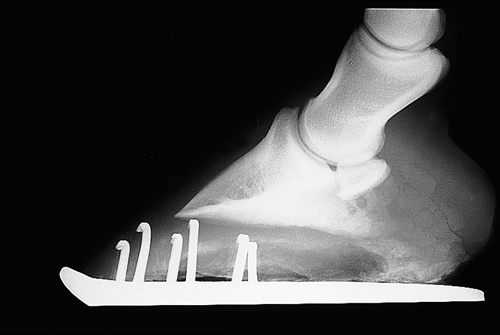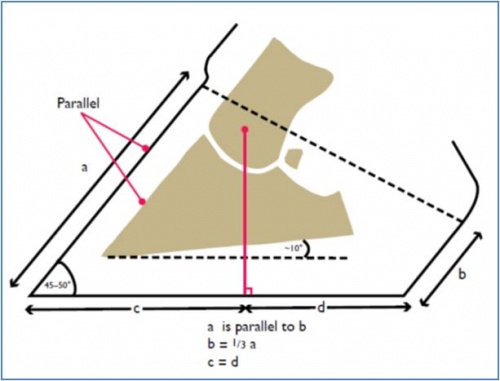Difference between revisions of "Equine Orthopaedics and Rheumatology Q&A 02"
Ggaitskell (talk | contribs) |
Ggaitskell (talk | contribs) |
||
| Line 16: | Line 16: | ||
*A perpendicular line from the centre of a circle drawn around the distal interphalangeal (DIP) joint intersects the weight-bearing surface of the foot close to the heels. The ideal foot conformation is shown in the diagram. | *A perpendicular line from the centre of a circle drawn around the distal interphalangeal (DIP) joint intersects the weight-bearing surface of the foot close to the heels. The ideal foot conformation is shown in the diagram. | ||
*This defective foot conformation is thought to exert abnormal pressure on the palmar soft tissue structures of the foot, leading to pain and possibly eventually navicular disease. | *This defective foot conformation is thought to exert abnormal pressure on the palmar soft tissue structures of the foot, leading to pain and possibly eventually navicular disease. | ||
| − | |l1= | + | |l1=Equine Phalanges - Anatomy & Physiology |
|q2=Discuss how this can be improved, and suggest what shoes should be applied. | |q2=Discuss how this can be improved, and suggest what shoes should be applied. | ||
|a2= | |a2= | ||
Revision as of 15:45, 3 June 2011
| This question was provided by Manson Publishing as part of the OVAL Project. See more Equine Orthopaedic and Rheumatological questions |
A four-year-old Thoroughbred presented with mild chronic bilateral forelimb lameness which responded to palmar digital perineural analgesia.
| Question | Answer | Article | |
| Comment on the foot balance and why this may be significant. | The radiograph shows a severely broken back foot–pastern axis, associated with long toe–low heel conformation.
|
Link to Article | |
| Discuss how this can be improved, and suggest what shoes should be applied. | The foot conformation can be improved by trimming the toe. ‘Dubbing’ the toe will shorten it in a dorsopalmar direction and reduce leverage. If it is possible to shorten the toe in a proximodistal direction, this will improve the angulation of the third phalanx.
Careful attention should also be paid to the medio-lateral balance of the foot. This will depend on the presence of limb valgus or varus but, in a straight limb, the medial and lateral walls should be of the same height with the medial wall slightly more vertical than the lateral. |
[[|Link to Article]] | |

